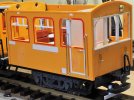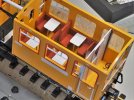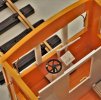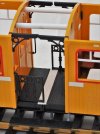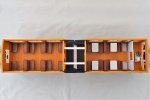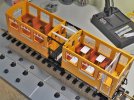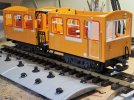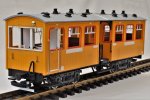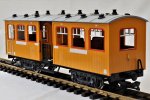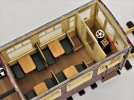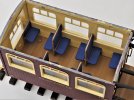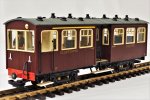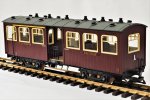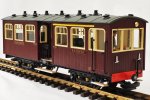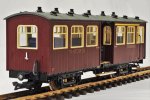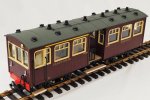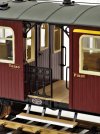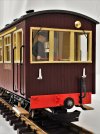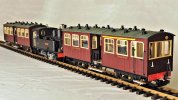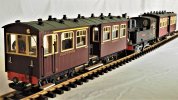David1226
Registered
Part 1 OF 3
This is the twin of auto-trailer No 16, constructed in the same way, using two LGB Train 4-wheel coaches Toy mounted on LGB Jackson Sharp bogies. The only difference is that the forward compartment, incorporating the driver’s cab, is First class, with tables fitted.
The starting point
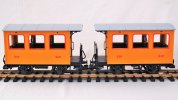
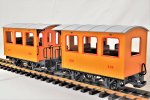
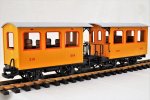
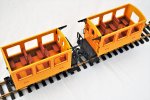
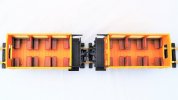
The first stage is to dismantle the two 4-wheel coaches. Having done that the new underframe is constructed using the frames of the two 4-wheelers. First the balcony ends are prepared for modification by removing the railings, brake stands, brake hoses and footsteps. The centres of the frames are then modified as below
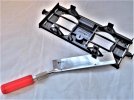
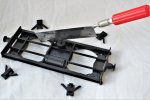
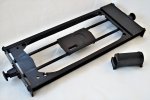
The ends are then prepared as shown below.
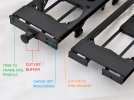
The buffer beams are drilled to accept bolts, each side, so that once the two ends are glued together, nuts and bolts can be added to add strength to the join. A strip of plasticard, of appropriate thickness, is then glued into the gap in the top decking. This is then scribed to match the planking/grain of the decking. The balcony steps are then screwed back on. An off-cut of plasticard is glued below the steps to span the gap. An off-cut of a spare step is then glued into the gap, fitting over the top of the plasticard to make one long step.
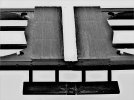
A spare set of steps (left over from previous conversions) were fitted at the cab end, below where the driver’s door will be.
Plasticard mounts were created, together with tube pivot, to mount the bogies. The bogies were fitted with Al Kramer bright nickel plated solid turned brass wheels, imported from the US. These give a very low centre of gravity. The brake hoses are refitted to the buffer beams at each end of the new bogie underframe.
One last addition to the running gear was to add a plasticard guard iron to the cab end bogie. I had to do it this way as there would have been insufficient clearance if I had attempted to fit it to the buffer beam.
The next thing to tackle is the modifications to the two 4-wheel bodies that will form the front and rear compartments of the coach. First the seat units are removed to be modified. For the rear compartment the only modification to the seats is to reduce the height of the back rests in the centre pairs.
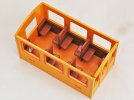
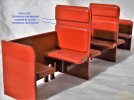
For the front compartment, the seat unit needs to be reduced in length to accommodate the driver’s cab. To fill in the gap between the front seats and the driver’s cab, a luggage rack is created on each side of the compartment, as shown below.
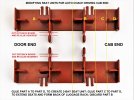
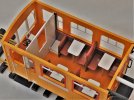
David
This is the twin of auto-trailer No 16, constructed in the same way, using two LGB Train 4-wheel coaches Toy mounted on LGB Jackson Sharp bogies. The only difference is that the forward compartment, incorporating the driver’s cab, is First class, with tables fitted.
The starting point





The first stage is to dismantle the two 4-wheel coaches. Having done that the new underframe is constructed using the frames of the two 4-wheelers. First the balcony ends are prepared for modification by removing the railings, brake stands, brake hoses and footsteps. The centres of the frames are then modified as below



The ends are then prepared as shown below.

The buffer beams are drilled to accept bolts, each side, so that once the two ends are glued together, nuts and bolts can be added to add strength to the join. A strip of plasticard, of appropriate thickness, is then glued into the gap in the top decking. This is then scribed to match the planking/grain of the decking. The balcony steps are then screwed back on. An off-cut of plasticard is glued below the steps to span the gap. An off-cut of a spare step is then glued into the gap, fitting over the top of the plasticard to make one long step.

A spare set of steps (left over from previous conversions) were fitted at the cab end, below where the driver’s door will be.
Plasticard mounts were created, together with tube pivot, to mount the bogies. The bogies were fitted with Al Kramer bright nickel plated solid turned brass wheels, imported from the US. These give a very low centre of gravity. The brake hoses are refitted to the buffer beams at each end of the new bogie underframe.
One last addition to the running gear was to add a plasticard guard iron to the cab end bogie. I had to do it this way as there would have been insufficient clearance if I had attempted to fit it to the buffer beam.
The next thing to tackle is the modifications to the two 4-wheel bodies that will form the front and rear compartments of the coach. First the seat units are removed to be modified. For the rear compartment the only modification to the seats is to reduce the height of the back rests in the centre pairs.


For the front compartment, the seat unit needs to be reduced in length to accommodate the driver’s cab. To fill in the gap between the front seats and the driver’s cab, a luggage rack is created on each side of the compartment, as shown below.


David

